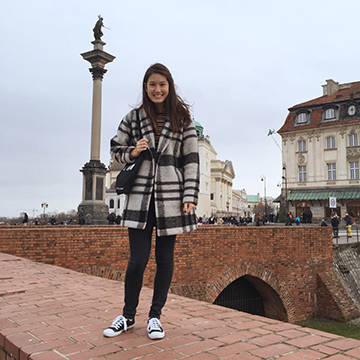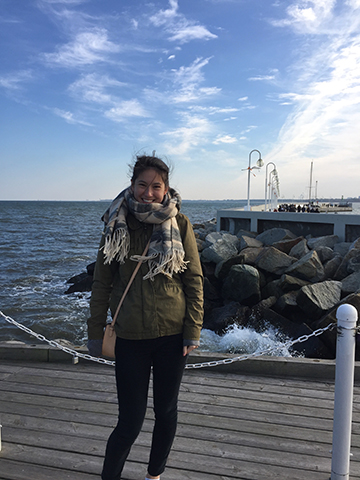Emma Chen in Poland

Emma on top of the castle wall in front of Sigismund III column in Warsaw.
Never in my life have I visited so many museums, churches, memorials, and other historical landmarks than in my time abroad. Information saturation definitely hit on certain packed-itinerary days, but the higher quantity surely did not equate lesser quality. Over the course of the past four months, I have had the privilege of studying abroad in Warsaw, Poland at Szkoła Główna Handlowa w Warszawie (SGH) and CIEE. Despite the university being Warsaw’s School of Economics, I was able to intensely study the history and sociology of Polish life. I was able to do this through various study tours to Polish towns of Kraków, Gdańsk, Słupca, Gńiezno, and Lublin, as well as cultural activities like attending a traditional Polish folk dance, seeing a modern Polish ballet, visiting the many local palaces, churches, and too many other places to count. Seeing the sights and artifacts left over, it brought to life the history in a way I had yet experienced up until that point – at least to such an extent. There is only so much comprehension that you can get from reading a textbook or other secondary source from the often-sterile environment of a classroom. But to set foot amongst buildings, some older than the sovereign United States, is something else entirely.

Emma at a pier in Gdańsk, Poland.
The most striking moment for me was at the end of our tour of Majdanek in Lublin. The sun was beginning to set as we made our way up the steps to a massive dome structure that was commemorating the victims of the Majdanek extermination camp. Expecting a plaque or sculpture of some kind, I was entirely taken aback as our tour guide solemnly explained to us that the massive pile in front of us was the ashes of the thousands of victims found after the camp’s liberation. The sheer magnitude of what was in front of me left me breathless and rendered me speechless for the two-hour drive back to Warsaw. I had never expected to be standing in the middle of a concentration camp, let alone two feet from the lives lost over its years of operation. Poland has often been described as “God’s Playground,” and seeing the evidence of the many invasions, battles, and horrific events that took place there brought new life and recognition to that title. Not only that, but I can see Poland beyond its role as a “victimized” nation, a homogenous Catholic country, or as a main stage for World War II. Even though I only got a glimpse into Poland, it is still a perspective I didn’t have before. Dziękuje, Warszawa.